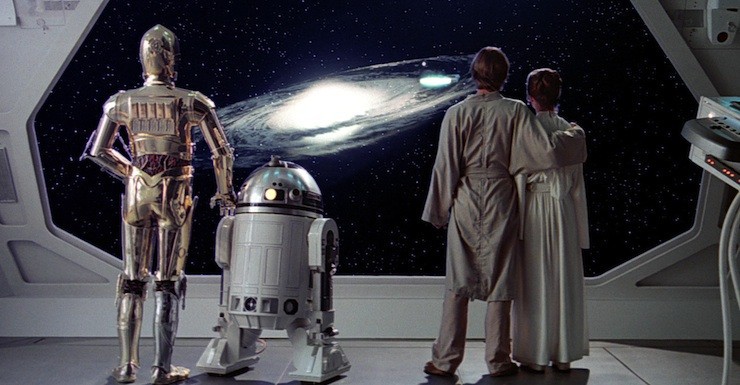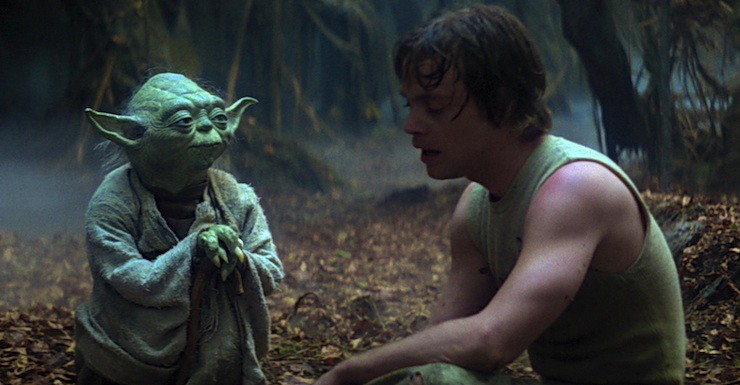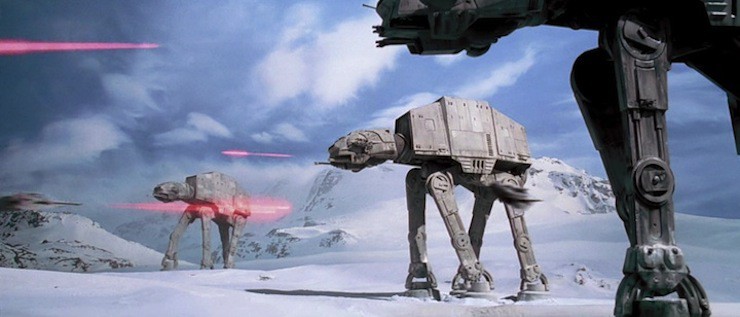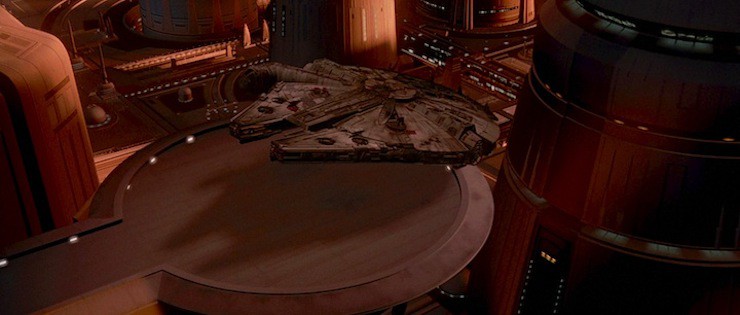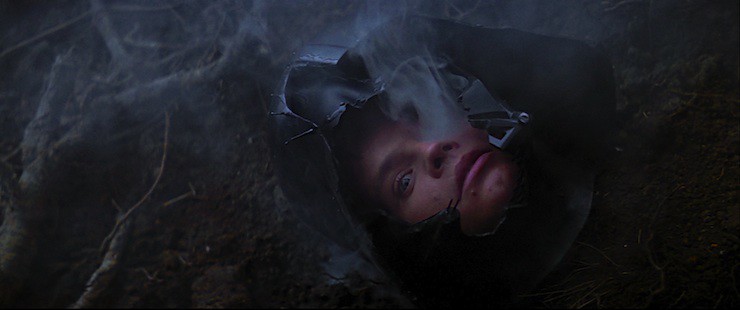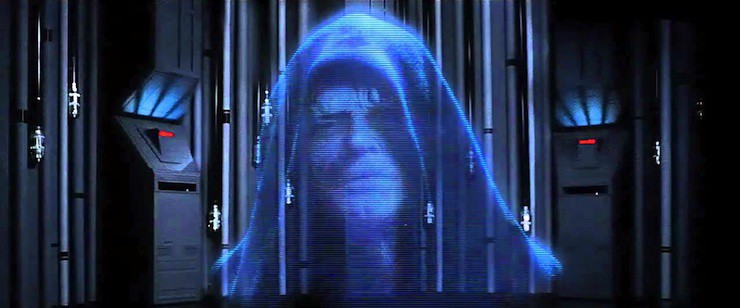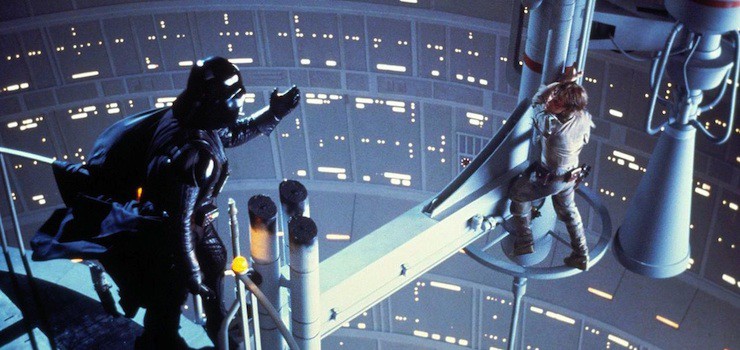When I was four years old, my dad piled my brother and me into the back of our 1978 Buick station wagon and took us to the drive-in to watch The Empire Strikes Back. I trembled with excitement for the whole ride, and when we got there, I bounced around like a bumblebee on crank waiting for the sky to grow dark and the opening credits to roll. When John Williams’ brassy fanfare finally belted out from the speakers, I squealed and clapped my hands and climbed into my dad’s lap.
I promptly fell asleep and didn’t wake up until it was over.
I’d missed the whole thing, but it didn’t matter: my older brother had seen it, and my cousins and my friends, and they all talked about it—incessantly. When it finally came out on VHS, I felt like I’d already seen it, not once, but repeatedly. The Empire Strikes Back had seeped into my consciousness through osmosis.

Thirty-five years later, it’s still seeping in. Considered by many to be the gold standard for Part 2 of a trilogy, Empire was such a mic drop that it continues to serve as a blueprint for countless sequels, in print and on the screen. So pervasive is its influence that we barely notice it anymore; it’s as invisible and omnipresent as the air we breathe. It’s in our bones—and for writers, it’s in the bones of our books too, whether we realize it or not.
At least, that’s my excuse and I’m sticking to it. All I know is that when I embarked on Book 2 of the Bloodbound trilogy, I didn’t have The Empire Strikes Back in mind—at least not consciously. And yet when I sat back and looked at the manuscript I’d just churned out, the echoes were unmistakable. Up to that point, I’d never realized how much I had internalized the lessons of Empire, but unbeknownst to me, I’d been a Padawan all along.
The experience really drove home for me just how successful The Empire Strikes Back had been at raising the stakes and ratcheting up the tension. More usefully, it also helped me highlight six clear ways in which Lucas and company made that happen.
Our heroes are split up.
While Luke, Leia, and Han spend most of Star Wars together, they’re wrenched apart in Empire. Han and Leia head off to Cloud City, while Luke makes his way to the Dagobah system. This traumatic separation heightens the sense of vulnerability. Luke is all alone on a creepy alien world facing perils unknown, while Han and Leia are cut off from the power of the Force, adrift in a hostile galaxy. The fellowship is broken, and our heroes are weaker and more exposed as a result.
The world is bigger, badder, and more complex than ever.
The galaxy expands in this second installment, offering us a glimpse at previously unimagined worlds. We trudge through the blizzards of Hoth, explore the floating towers of Cloud City, and prowl the fetid swamps of Dagobah, encountering varied nasties along the way. In so doing, we learn more about the Force as well as the machinations of the Empire, both of which turn out to be more complicated than we thought. This vast backdrop seems to swallow our heroes (at one point literally). And in case we missed it, there are plenty of environmental cues to hammer it home: immense, lumbering star destroyers; AT-ATs trampling puny rebel soldiers as if they were ants; Darth Vader looming ominously over Luke in Cloud City. All this serves to highlight how small and fragile our heroes really are, how overwhelmed.
The theme of the journey.
As in Lord of the Rings and many other epics, the characters in Empire do a lot of travelling, and this physical journey parallels character development. Just as the setting is growing and becoming more complex, so too are the characters, and as the world darkens, our heroes show their darker sides too (more on this below). This added scope and complexity is what gives the story its truly epic feel.
Evil comes from within.
Star Wars presents a fairly straightforward conflict between Good and Evil, personified by Darth Vader and Obi-Wan (who passes the lightsaber to Luke). But in The Empire Strikes Back, this black-and-white conflict quickly starts to acquire shades of grey, and one of the central themes of the trilogy—that good is constantly in danger of being corrupted—takes centre stage. Luke is no longer just a hero seeking to thwart evil; he’s in danger of becoming evil himself. And even if he doesn’t quite embrace the Dark Side and give it a big sloppy kiss, he’s definitely doing some flirting when his temper gets the better of him. Suddenly, it’s not just our heroes’ lives in danger, but their very souls. And failure looms larger than ever, because even winning (defeating Vader) might mean losing (being seduced by the Dark Side).
The enemy has a bench, and it’s deeper and scarier than we thought.
(This is a sports metaphor. That’s allowed, right?) We spent Star Wars more or less convinced that Darth Vader was the baddest badass in the land, only to learn… not so much. Empire introduces us to Palpatine, and we’re quickly given the deeply unsettling impression that Vader is the least of our worries. Could the epically scary villain of the first film be little more than a particularly talented slugger on Palpatine’s bench-o-baddies?
The late-breaking shocker.
Enough said, right? Bad enough that we crawl across home plate bloody, bruised and behind on the scoreboard. (Another sports analogy. Forgive me—the Blue Jays are doing really well.) On top of that, we end the film with our ears still ringing to this little gem: “I am your father!” Suddenly, our epic tale is also intensely personal. We’re hurting for Luke and fearing what lies ahead, knowing our hero is in for a world of pain and tough decisions in Episode III (or, you know, Episode VI). We’re disoriented and anxious. Most importantly, we’re positively starving for the next installment.
When you break it down like this, it’s genuinely impressive just how systematically Empire ramped up the tension from Star Wars and set the stage for Return of the Jedi – especially considering that this list is almost certainly incomplete. I have no idea whether Lucas and company planned this out meticulously or if it was purely instinctive, but it’s hard to deny how successful the results were.
Which explains why, where I would normally be annoyed with myself for having unconsciously echoed so many themes from another work, in this case I gave myself a pass. Because every artist learns from the masterpieces, and there’s no doubt in my mind that The Empire Strikes Back qualifies as such. If you weren’t convinced of that the first time you watched it, take another look. “You will be.”
Erin Lindsey is on an epic quest to write the perfect vacation novel for fantasy lovers. The Bloodforged, Book 2 of the Bloodbound trilogy, publishes September 29 from Ace. She also writes fantasy mystery as E.L. Tettensor. Follow her on Twitter @etettensor.










